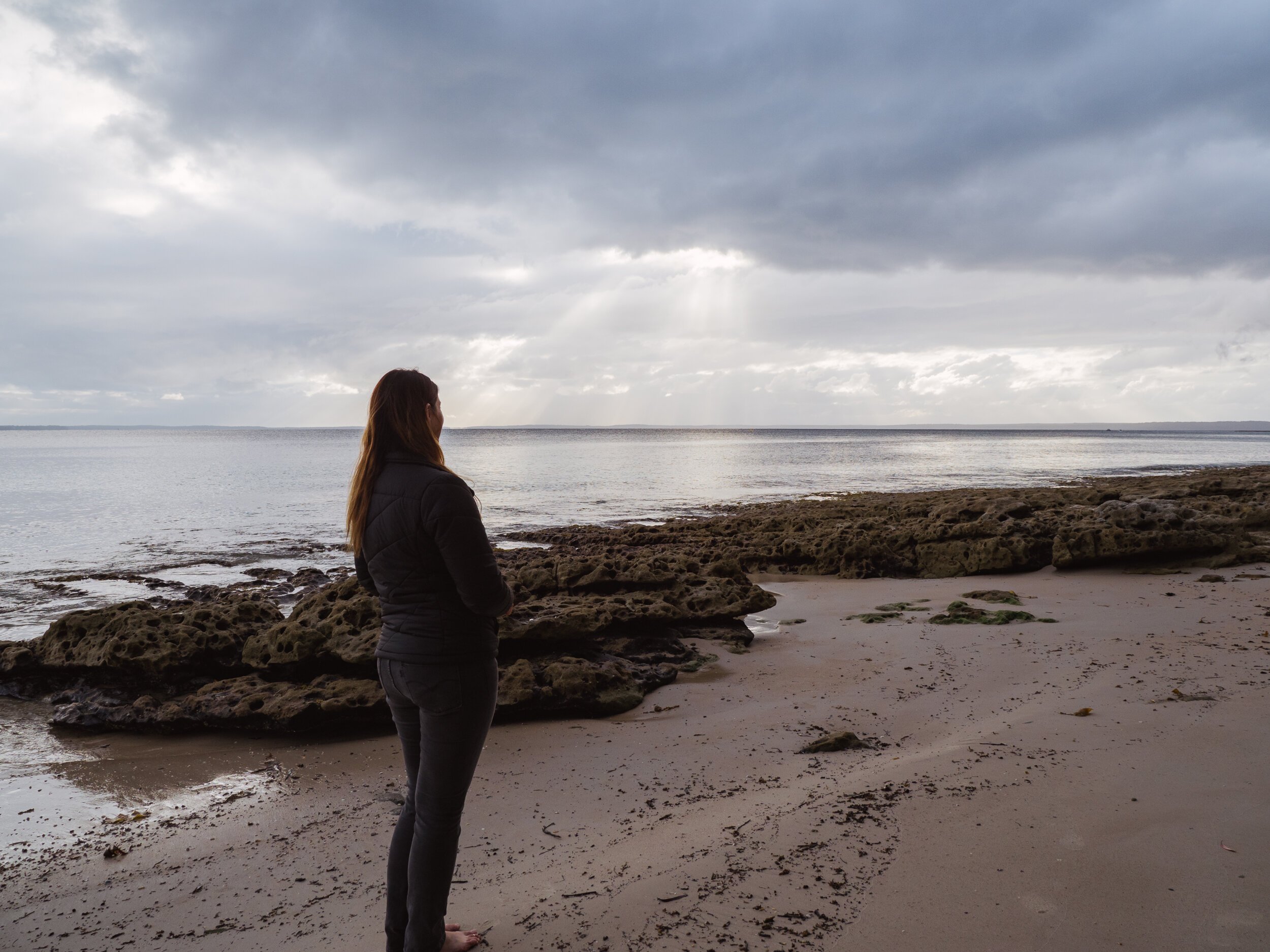
Joni Pini-Fitzsimmons
Joni Pini-Fitzsimmons is a ray-obsessed researcher who is working hard to uncover the movements of these mysterious creatures through her project, The Stingray Diaries.
Joni is looking at the behavioural movements of stingrays in southeastern Australia, along the coast of New South Wales. After a long day of fishing in many popular places along the NSW coastline, fishermen cut up their fish and feed the scraps to the stingrays that congregate around the fishing ramps.
Nobody has looked at whether this activity is causing shifts in the rays movements, or their foraging behaviour - until now. Joni is studying how these stingray’s interact with fishermen, in an attempt to find out what kind of impact this is having on these charismatic ‘spiky pancakes’.
What inspired you to become a marine biologist?
I was really fortunate to grow up in Cottage Point, which is on the shores of the Hawkesbury River in Sydney. My brothers and I spent every day from dawn until dusk, down in the water playing around and exploring. Apparently, when I was four years old, I told my mum that I was going to be a marine biologist while standing defiantly on the beach. So, you know, the rest is history.
Why should people give a damn about stingrays?
Stingrays are so underrated. The more that I read about them, the more that I learn about them, the more I want to know. They're incredibly charismatic, and they're also really threatened.
They face a lot of threats from human activity. A lot of rays are coastal. They tend to come into contact with humans a lot, with fishing gear and that kind of thing.
They're also really important in coastal ecosystems. So being a benthic species, they provide these essential links in food webs. They forage and predate on smaller things, and there's bigger things that predate them. The rays form these linkages in marine ecosystems and if you remove them, you can break up that ecosystem.
What makes smooth rays, in particular, so unique?
Smooth rays are the biggest species of marine stingray in Australia. They are a hot contender for the biggest species of marine stingray around the world, but there's another species that is pretty close. But again, we don't know enough about them to be able to compare them.
Smooth stingrays grow to about two and a half metres wide and can weigh up to 350 kilos. They are really common along the coastline of southern Australia, as well as around New Zealand and South Africa.
You always see them interacting with humans. Humans tend to have this real connection with them in the areas that they do get to see them up close. Rays also have this series of ‘freckles’ along the sides of their faces, these white dots that you can use to identify individuals - kind of like a fingerprint.
What threats are rays facing?
Rays are threatened by a number of different things. Because a lot of species are coastal, they tend to interact with humans more often. Things like habitat modification, fishing activity and human-induced climate change are impacting them. They often get caught up in fishing nets as bycatch.
They also have traits that make them particularly susceptible to threats. Rays tend to be slow-growing. They reach maturity quite late in their life, and when they do reproduce, they only have very few pups that take a long time to develop. If there are impacts on their population numbers, they aren't able to recover as quickly as we'd hoped. In a lot of cases, they just can't keep up with the rate of population loss.
How do you study these rays?
For this research, we are using a whole range of different technologies. The main one that we're using is acoustic telemetry, which is where we attach a small acoustic tag to the stingrays. Then in areas of interest, we have what's called a listening station or a receiver. Every time that a tagged stingray swims within range of these receivers, it gives us an alert that tells us which ray it was, when it was there and where it was so that we can link the data from all these different areas together, and we can see their movements around a much bigger area.
In Jervis Bay, which is my main study site, we have about 50 receivers around the edge of the bay. We can follow the rays movements and see where the hotspots of activity are, and if it relates to the fish cleaning activity that we're seeing.
Another technology that we're using is stable isotopes to look at their diet. That's where we take a small tissue sample and we look at different levels of isotopes in those tissue samples. We can generally tell what type of prey items that they're eating, and whether most of their diet is coming from these fish cleaning activities or not.
The third technology that we're using is genetic analysis. We don't know very much about this species in general and we're trying to figure out roughly how big the population is in this area. We use a small tissue sample, have a look at their DNA and see how related they are and we can estimate how big the population is in this area.
What kind of results are you finding?
Some of the main results that we're seeing, particularly from the acoustic tracking, is that the stingrays are using these areas where they're getting fed a lot more often than other areas, and there tends to be daily patterns in the use of these sites.
Generally in the morning, they are usually out of the area, potentially resting, maybe foraging. Then in the afternoons, when there's often more fish cleaning and there are more fishermen coming back from their day of fishing, the rays tend to congregate at these areas where there's a chance of getting a free feed. They seem to spend the rest of the afternoon there, before they head back out for the night time, which is potentially when they should be foraging naturally.
Is it a bad thing that the rays are changing their behaviour?
We don't really know enough to know whether this is having an impact on their behaviour or their natural movement patterns, because this is the first time that such a study has been done.
It's a lot of exploration and it's going to take a little while until we can actually definitively say whether it's having a negative impact on their physiology or their behaviour. But it provides us with a baseline that we can base monitoring on into the future, to see if in the long term this activity is affecting them.
Could this fish cleaning activity connect fishermen to marine life they may not normally have a chance to interact with?
One of my favourite things about doing fieldwork down here is getting to talk to all the local fishermen that are actually engaging in this activity. The general consensus is that it's ecologically benign. You know, they caught the fish from the ocean. It's going back into the ocean and it's feeding an animal.
They tend to refer to these big stingrays as their pets because they are so big and charismatic. They're really protective of them. A lot of them were a little standoffish when I was coming in and trying to do research on the rays because they thought that was going to have a big impact on them.
Whereas the feeding of fish to them, they say that is a way of helping the animals because they don't have to hunt naturally and they don't have to use all that energy. They tend to just have this real connection with the animals, and I really love to see that. As we get more and more results, I plan on talking to the fishermen about why it could potentially be impacting the rays, and how to engage in this activity and connect with nature in a less impactful way. I feel that they're probably going to be quite receptive to that now that I've had a bit of time to get to know them.
Stingrays sound pretty mysterious. Have you discovered anything interesting about them by doing this research?
A lot of the work that we're doing is surrounding this fish cleaning activity, but we're also finding all these sorts of general ecological, behavioural things. Because we know almost nothing about them, it's surprising to us.
A lot of the stingrays that we do see coming into the sites where they're getting fed the fish scraps are female.
Even though we've been doing this for the past three years, we've never actually seen a male until last year. We finally got to tag two males and tracked them acoustically. What we've found is that they tend to be more pelagic. They're out in deep water, and we even had one male do a 200-kilometre migration down south and then come all the way back into Jervis Bay, which was completely unexpected.
What we're thinking is that the males tend to be further out in deeper water and then the females spend most of their time in the bay and they'll head out to breed and then they'll come back into the bay, whereas the males will stay outside the bay.
How long does the Stingray Diaries run for?
The Stingray Diaries is a four and a half year project. I started doing this work during my master's degree and we've got about 18 months left now. In the next 18 months, we're going to have a lot of the data coming back to us, doing lots of analysis to see if we can see any trends and any impacts. After that, we will reassess whether there needs to be monitoring programs put in place, and we'll be talking with fisheries to see if there's something that we can do to help this relationship.
How can people get involved with the Stingray Diaries?
You can head to the Stingray Diaries website and you can report your sightings of stingrays in the Jervis Bay or South Australian region. We can use that information, especially if you take photographs, to try and identify individuals and get a bit more data about where they're going, especially in places where we don't have listening stations in place.




